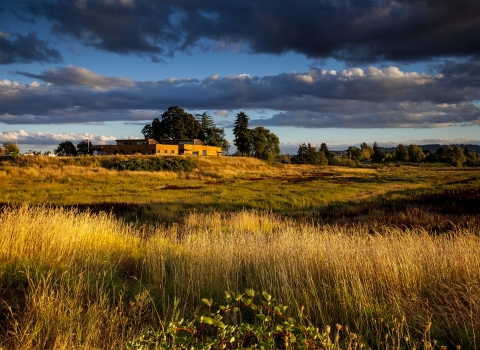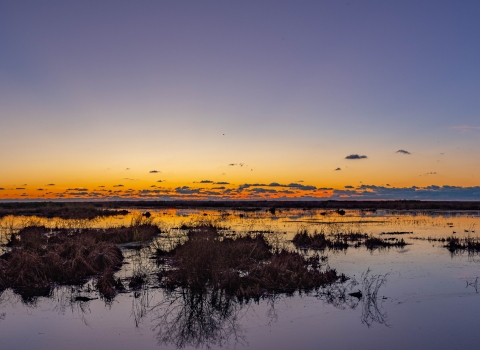The Condor Cam, hosted by Cornell Lab of Ornithology and the Santa Barbara Zoo in partnership with the U.S. Fish and Wildlife Service, returned for the seventh year with a live streaming video of a new condor pair nesting in Toms Canyon on Hopper Mountain National Wildlife Refuge in Ventura County, California. Saturday, May 14 at 05:42 am, viewers around the world got a real-time look at a hard-won conservation success story with a first sighting of a freshly hatched condor chick.
Thanks to the Condor Cam, people from around the globe can get up-close-and-personal with first time breeder, five-year-old female condor #846, her mate, 14-year-old male condor #462, and their newly hatched chick. This is the pair’s first nesting attempt together, and they are using a nest cavity that was previously used in 2020 by #462 and his former mate, female condor #594. This is the first year a camera has been placed in this cavity.
In 2016, followers of the Condor Cam watched a chick hatch live in the wild for the first time in history from another cliff-side nest on Hopper Mountain NWR. Each year, livestreaming video of California condor chicks gains worldwide attention, attracting hundreds of thousands of viewers from all over the world.
“By providing a virtual window into the natural world of condors, livestream cams foster important connections between people and wildlife,” said Charles Eldermire, Cornell Lab Bird Cams project leader. “This is an incredible opportunity to watch an active experience unfolding in real time, and it increases community engagement with these powerful birds. We’re hopeful that this will help to spread awareness about the fascinating lives of condors and the challenges they face in the wild.”
The 2021 nesting season in Southern California resulted in just two successfully fledged chicks (condor #1106, from parents #328 and #216 and condor #1110, from trio #585, #111, and #616). Program-wide, 2021 saw 15 successfully fledged chicks in the wild across all the release sites including Arizona and Central California. In Southern California, the 2022 season looks promising, with 6 – possibly even 7 – active nests.
“We are excited about the 2022 nesting season, especially after last year’s low success rate. Auspicious numbers like these are a testament to the power of our collaborative efforts, and we are grateful to our many partners for their tireless conservation work. We have good reason to be optimistic about the future of the California Condor Recovery Program, and we’re excited to continue building on this work,” said Arianna Punzalan, supervisory wildlife biologist with the Service’s California Condor Recovery Program.
The number of California condors dropped dramatically in the mid-20th century, leading the Service to designate the species as endangered under the Endangered Species Act. By 1982, there were only 22 of the iconic birds left in the wild. Today, due to intensive ongoing captive breeding and recovery efforts led by the Service in conjunction with multiple public and private partners, the California condor population has grown to just over 500 birds worldwide, with more than half of the population flying free.
“Condors fought their way back from dangerously low numbers just a few decades ago, and we’re thrilled to see years of conservation work pay off with another successful wild hatching,” said Dr. Estelle Sandhaus, the Santa Barbara Zoo’s Director of Conservation and Science. “We’re cautiously optimistic that we’ll have more good news to report this year from the other active nests. These are truly magnificent birds, and it’s exciting to be able to share this remarkable experience with the world through the Condor Cam.”
In California, wild condors nest, roost and fly in the mountains of Monterey, San Benito, San Luis Obispo, Santa Barbara, Ventura, Los Angeles, Kern, Tulare and Fresno counties, and the Sierra Nevada Mountains. Now, with the historic release of two condors earlier this month, condors have added the redwood forests of the Pacific Northwest to their habitat range.
Male condor #462 previously paired with female condor #594 in 2018 and 2020, successfully fledging one chick each year. Last year, the Condor Cam livestreamed condor #594’s nest at Huttons Bowl, which failed after the sire, condor #374, died and male condor #247 displayed territorial aggression and pulled the Huttons Bowl chick from the nest. The necropsy report for condor #374 is still pending.
The number one killer of California condors is lead poisoning, caused by condors feeding on carcasses containing lead bullet fragments. Peer-reviewed research shows that lead poisoning is a serious health problem for both wildlife and humans, and the Service is working with partner organizations and the hunting community to transition to the use of non-lead ammunition alternatives. Many hunters continue their proud tradition of wildlife conservation by using these non-lead alternatives.
Another threat specific to condor chicks is “micro trash.” Micro trash refers to small coin-sized trash items such as, nuts, bolts, washers, copper wire, plastic, bottle caps, glass, and spent ammunition cartridges. Condor parents collect these items and feed them to their chicks, which can cause serious problems with the chick’s development. While biologists do not completely understand why this occurs, many believe that the condor parents mistake these items for pieces of bone and shell which provides a source of calcium if fed to the chick.
Conservation efforts toward the recovery of the California condor are achieved only through partnerships amongst federal and state agencies together with private landowners and organizations. The Huttons Bowl Condor Cam is made possible through access provided by private landowners, and through the financial and technical support of the U.S. Fish and Wildlife Service, Santa Barbara Zoo, Cornell Lab of Ornithology, the Western Foundation of Vertebrate Zoology, Disney Conservation Fund, Friends of California Condors Wild and Free, Arthur L. & Elaine V. Johnson Foundation, and numerous other partners.
CONTACTS:
Arianna Punzalan, arianna_punzalan@fws.gov, 805-377-5471
Jennifer Zacharias, Santa Barbara Zoo, jennifer@jzpr.com, 805-886-9078
Pat Leonard, Cornell Lab of Ornithology, pel27@cornell.edu, 607-254-2137
***
Photos for media: http://ow.ly/JLGx50JbANO
To watch the Condor Cam, visit: www.allaboutbirds.org/condors
For answers to frequently asked questions about the nest cam, the parents and the chick, visit: https://fws.gov/program/california-condor-recovery
The U.S. Fish and Wildlife Service works with others to conserve, protect, and enhance fish, wildlife, plants, and their habitats for the continuing benefit of the American people. For more information about our work and the people who make it happen, visit http://www.fws.gov/cno or connect with us via Facebook, Twitter, YouTube, and Flickr.
The Cornell Lab of Ornithology is a membership institution dedicated to interpreting and conserving the earth’s biological diversity through research, education, and citizen science focused on birds. Visit the Cornell Lab’s website at birds.cornell.edu
The Santa Barbara Zoo is located on 30 acres of botanic gardens and is home to more than 500 individual animals in open, naturalistic habitats. It is accredited by the Association of Zoos & Aquariums (AZA), representing the highest level of animal care, and participates in AZA cooperative programs for endangered species including Masai giraffe, California condor, radiated tortoise, island fox, and Western lowland gorilla, among others. Visit www.sbzoo.org
The Western Foundation of Vertebrate Zoology (WFVZ) is both a natural history collection specializing in eggs and nests of birds from all over the world, and a research and education institution dedicated to studying and teaching about the conservation of the world’s bird species. The WFVZ has contributed information to thousands of research projects since its inception in 1956. Visit us at www.wfvz.org, and on Facebook and Instagram.



